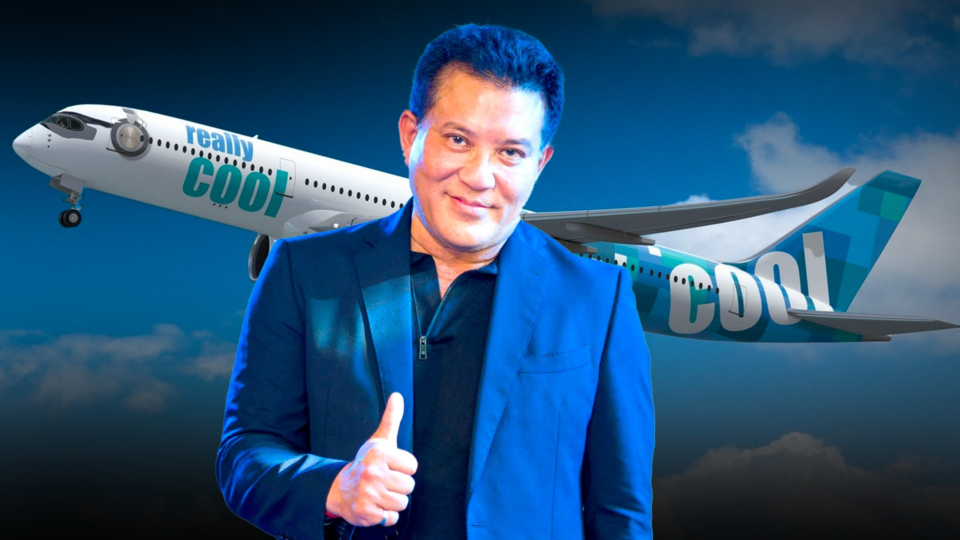Thailand looks to welcome a fresh, concept-based long-haul airline, Really Cool Airlines. The Bangkok-based carrier would operate a fleet of widebody aircraft to major Asian gateways, at least initially, to increase passenger inflow to the country.
Patee Sarasin, CEO of Really Cool Airlines, aims to differentiate around innovation and technology to meet the customer of today and create a product that lasts.
“People are a lot more impatient with technology today, and this is not specific to Thailand but is all over the globe. We understand this behavior change, and based on that, we establish our products and offers. We’re putting in a lot of effort to be able to reach this customer base.“
Patee Sarasin speaks to Airways magazine.
What is your concept, and why ‘Really Cool Airlines’?
Really Cool—the words themselves give you freedom. Freed to expand horizontally and vertically. It’s also innovative and positive; there’s not much to explain, and this in turn covers most of the global market and remains sustainable. It’s timeless to age.
In terms of the airline itself, we don’t want to be the biggest because that’s costly. We don’t want to claim to be the best because it’s an ongoing business, but we want to be the most innovative in the world. We’re always moving forward.
Really Cool can be expanded to other territories on the non-aviation side too to bring in further revenue that can help sustain the industry if it hits the fan again. We’re in a good cycle at the moment.
What is the ‘cool’ element?
It’s the total experience. I was an ad man for 20 years, and in advertising, you always find something cool to deliver with the least investment. Products on most airlines are very similar today, but I think there’s a lot more you can do. It’s the whole journey, before even booking the tickets and after the end of travel.
I can’t disclose too much about what we want to do at this moment. As we progress, we will continue to differentiate and bring in innovation. It’s the little things, and they do matter. Customers will see a lot of ‘cool’ stuff.
Right then, when does Really Cool take off?
We’re looking at the second quarter of next year (2024) to start scheduled flights. We will use wide bodies and fly long-haul. Furthermore, we want to complement rather than compete with other airlines, both international and domestic; in that way, we will interline and network with other carriers.
WE’RE OPEN TO PARTNERSHIPS AND CODESHARE. WE’VE BEEN DISCUSSING THIS WITH JAPAN AIRLINES AND STARLUX.
Patee Sarasin, Really Cool Airlines CEO
Have you received your AOC?
We have commenced the process, and it’s moving forward. We expect it by December or January of next year and thereafter to prove flights. If all goes well, I’d like to fly our aircraft to the Singapore Air Show in February.
Three Airbus A330-300s as part of the initial fleet?
Actually, four A330-300s; that’s what we’re looking at. By 2025, we want to bring in the Airbus A350s for us to fly longer, and they will complement the A330s. Our focus in the first year would be the Asia-Pacific region. Japan, Hong Kong, China, South Korea, and even Israel. We’re ambitious; it’s hard with four aircraft, but it’s okay, we’ll do it. We’re looking at reducing the per-aircraft utilization from 16 to approximately 13 hours a day.
“WE’D LIKE TO FLY TO JAPAN—TOKYO, NARITA, AND NAGOYA. SHANGHAI IN CHINA AND TEL AVIV IN ISRAEL WILL BE OUR DESTINATIONS AS WE PROGRESS FORWARD.”
Patee Sarasin, Really Cool Airlines CEO
You’ve been running airlines in Thailand for a long time; how has the Thai market changed in terms of air travel?
It’s changed a lot, especially during the COVID period. Look at the corporate market; lots of companies don’t want C-levels to even fly first. Big moves to business class. Managers are moving down to the premium economy level. So I don’t see why many airlines are hosting first class, even today. There’s no demand, and it doesn’t bring in that much money.
In the leisure market, there is tremendous growth. People want to go places, and their behavior has also changed from just buying expensive products to having great experiences and sharing them all over social media. You’ve noticed how things have changed, be it TikTok, or Instagram, it’s all over.
It’s becoming more of an image for travelers today, and it widens the market because everyone sees it.
We’re seeing how airlines are performing worldwide and observing in terms of what’s working, what’s good, and what’s not.
A Wrap Around The Thai Aviation Market
As per Bangkok Post, Thailand hosted 11.4 million tourists to the country from January to June 11 of this year, which exceeds the full year of 2022, proving high demand. Airports of Thailand (AOT) forecasts the three major airports around Bangkok – Suvarnabhumi (BKK), Don Muang (DMK) and U-Tapao (UTP) will see a recovery in passenger traffic to 2019 levels by around 2025. BKK’s expansion and new terminal are expected to be complete in 2024.
On the International long-haul side, Thai Airways remains the front-runner, followed by Thai Air Asia X, indicating room for a new long-haul carrier that can actually complement rather than compete. Domestic airlines remain plentiful and compete: Thai Smile, Nok Air, Thai Air Asia, Thai Vietjet, and Thai Lion Air.
Patee concluded, “We will complement domestic as well with local airlines. We will help them fill their planes up domestically, and likewise, they would help us fill ours internationally.”
Credit to Airways Magazine
READ MORE: https://bangkokone.news
SOURCE: https://airwaysmag.com




